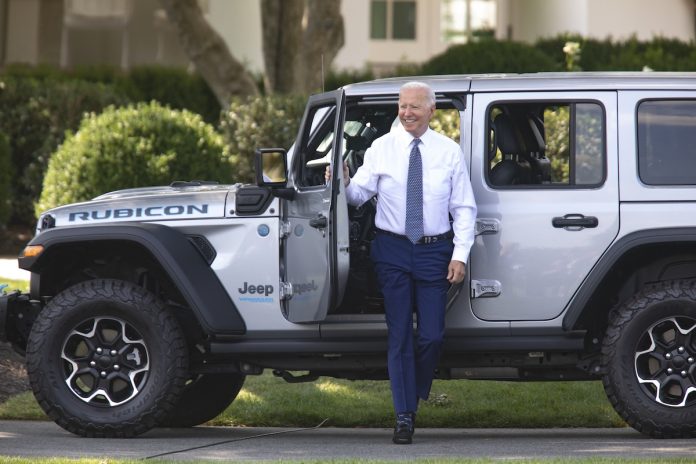WASHINGTON—President Joe Biden on Thursday announced a multistep strategy aimed at rapidly shifting Americans from gasoline-powered cars and trucks toward electric vehicles—a central part of his plan to reduce the pollution that is heating the planet.
Biden is first restoring and slightly strengthening auto mileage standards to the levels that existed under President Barack Obama but were weakened during the Trump administration. The new rules, which would apply to vehicles in the model year 2023, would cut about one-third of the carbon dioxide produced annually by the United States and prevent the burning of about 200 billion gallons of gasoline over the lifetime of the cars, according to a White House fact sheet.
The administration next plans to draft even more stringent pollution rules for both passenger vehicles and heavy-duty trucks that are designed to compel automakers to ramp up sales of electric vehicles.
“There’s a vision of the future that is now beginning to happen, a future of the automobile industry that is electric—battery electric, plug-in hybrid electric, fuel cell electric,” said Biden, who announced the plan from the South Lawn of the White House before an array of parked electric vehicles, including the Ford F-150 Lightning, the Chevrolet Bolt EV and a Jeep Wrangler. “The question is whether we’ll lead or fall behind in the future.”
Biden’s actions amount to an attempt to overhaul a major American industry in order to better compete with China, which makes about 70% of the world’s electric vehicle batteries. In an effort that blends environmental, economic and foreign policy, Biden wants to retool and expand the domestic supply chain so that the batteries that are essential to electric vehicles are also made in American factories.
“This is the first example of how Biden’s administration would do industrial policy in the climate change context,” said Michael Oppenheimer, a professor of geosciences and international affairs at Princeton University.
Without a radical change to the type of vehicles Americans drive, it will be impossible for Biden to meet his ambitious pledge to cut planet-warming emissions by 50% from 2005 levels by the end of this decade. Gasoline-powered cars and trucks are the largest single source of greenhouse gases produced in the United States, accounting for 28% of the country’s total carbon emissions.
He also signed an executive order that calls for the government to try to ensure that half of all vehicles sold in the United States be electric by 2030.
In a signal of industry support, the president was joined on the South Lawn by the CEOs of the nation’s three largest automakers, as well as the head of the United Auto Workers. The automakers pledged that 40% to 50% of their new car sales would be electric vehicles by 2030, up from just 2% this year, on the condition that Congress passes a spending bill that includes billions of dollars for a national network of electric vehicle charging stations, as well as tax credits to make it cheaper for companies to build the cars and consumers to buy them.
A rapid transition to electric cars and trucks faces several challenges.
Experts say it will not be possible for electric vehicles to go from niche to mainstream without making electric charging stations as ubiquitous as corner gas stations. And while labor leaders attended the White House event and referred to Biden as “brother,” they remain concerned about a wholesale shift to electric vehicles, which require fewer workers to assemble.
Biden laid out the stakes in stark terms, calling the transition an act “to save the planet.”
With the impacts of a warming planet seen in record droughts, deadly heat waves, floods and wildfires around the globe, scientists say that simply restoring Obama-era climate controls will not be enough.
“Obama started the work of moving us in the right direction to deal with climate change,” said Michael Gerrard, director of the Sabin Center for Climate Change Law at the Columbia Law School. “Trump tore all of that apart. Biden is now putting the pieces back together. But we are way behind. The much harder work is yet to come. The wholesale conversion of the transportation system and electric power system are World War II-scale enterprises, and it’s just starting.”
The tailpipe emissions regulations enacted by the Obama administration in 2012 required that passenger vehicles sold by automakers achieve an average of roughly 51 mpg by 2025. Donald Trump loosened the standard in 2020 to about 44 mpg by 2026. The new Biden standard would be 52 mpg by 2026.
The White House estimates the regulations would cut 2 billion tons of carbon dioxide, about one-third of the total annual carbon dioxide pollution produced by the United States, and prevent the burning of about 200 billion gallons of gasoline.
The Biden administration then plans a set of tougher emissions regulations for vehicles produced beyond 2026. It is those rules that Biden hopes will essentially propel automakers to phase out the internal combustion engine. Since that second set of rules could be technically complex and legally ambitious, administration officials decided to first quickly reinstate the Obama regulations to cut some emissions while federal staff members take on the challenge of writing the future rule.
“Depending on how they write it, that second rule will either put us on a pathway toward widespread use of EVs by later this decade — or it won’t,” said Jeff Alson, a former Environmental Protection Agency senior engineer and policy adviser who worked on the Obama auto emissions standards.
“It will be a challenge because regulatory agencies find it difficult to force major technology change,” Alson said. “It’s pretty rare. If you want to replace an internal combustion engine with a battery pack, and replace the transmission with electric motors — that’s replacing the guts of gasoline-powered cars. Forcing that kind of change will not be easy for federal agencies and politicians to do unless they have the support of the public and the automakers.”
In a joint statement, Ford, General Motors and Stellantis, the auto company formed this year after the merger of Fiat Chrysler and Peugeot, announced their “shared aspiration” to achieve sales of 40% to 50% electric vehicles by 2030.
But they need government support and a “full suite of electrification policies” to translate aspirations into action, they wrote.
Specifically, the automakers want Congress to provide incentives for car buyers and pay for a charging network, investments in research and development and incentives to expand the electric vehicle manufacturing and supply chains.
Biden has asked Congress for $174 billion to create 500,000 charging stations. An infrastructure bill pending in the Senate includes just $7.5 billion. However, it also provides $73 billion to expand and update the electricity grid, an essential step for carrying power to new auto charging stations. A second bill, which could move through Congress this fall, could include far more spending on electric vehicles, consumer tax incentives and research. Neither proposal is guaranteed to pass in the closely divided Congress.
The International Council on Clean Transportation, a research organization, concluded that the nation would need 2.4 million electric vehicle charging stations by 2030 — up from 216,000 in 2020 — if about 36% of new car sales were electric.
Some environmental groups expressed skepticism that the auto companies would follow through on their promises.
“Voluntary pledges by auto companies make a New Year’s weight-loss resolution look like a legally binding contract,” said Dan Becker, director of the Safe Climate Transport Campaign at the Center for Biological Diversity. “Global warming is burning forests, roasting the West and worsening storms. Now is not the time to propose weak standards and promise strong ones later.”
Some automakers are already retooling for an all-electric future in part because of policy changes elsewhere. The European Union has announced that all new cars sold will be emissions-free by 2035. In the United States, California and Massachusetts have made the same commitment, while Washington state has set an earlier deadline of 2030. General Motors has said it will sell only zero-emission vehicles by 2035.
Labor unions, meanwhile, have expressed uneasiness about a transition to electric vehicles, which require about one-third fewer workers to assemble than gasoline-powered cars or trucks.
In a statement, Ray Curry, president of the United Auto Workers said: “While the UAW notes that the companies have made voluntary commitments on electric vehicles, the UAW focus is not on hard deadlines or percentages, but on preserving the wages and benefits that have been the heart and soul of the American middle class.”
Biden’s effort to shape the auto industry, by combining his climate agenda with his focus on competitiveness with China, is only the latest example of how the administration is concentrating on industrial policy. In June the president pushed through the Senate one of the most ambitious pieces of industrial-policy legislation, committing $52 billion to the semiconductor industry, and an additional $195 billion for research and development over the next decade.
Ultimately, however, the success of Biden’s automobile plan will depend on whether Americans put their trust in an entirely new kind of car.
“In the world of electrification, you’ve got the regulations, which the executive branch can do, and the need for complementary infrastructure, which is up to a divided Congress,” said David G. Victor, co-director of the Deep Decarbonization Initiative at the University of California, San Diego. “And then you’ve got the need for a change in human behavior, which is largely uncharted territory.”
This article originally appeared in The New York Times.










